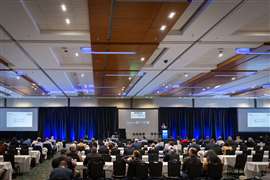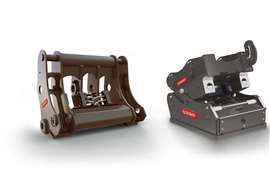Christchurch recovers - slowly
07 October 2014

At a conservative estimate, it will cost more than NZ$40 billion (US$32.5 billion) to rebuild Christchurch and its environs, and some economists predict it will take the New Zealand economy 50 to 100 years to recover from the ‘quakes.
Gone is the ‘Red Zone’ of the central business district (CBD), a vast area hastily cordoned off after the February 2011 earthquake. Its reopening was top priority for the Canterbury Earthquake Recovery Authority (CERA), the organisation endowed with wartime-like powers to oversee the city’s rebuilding. But Red Zones remain elsewhere.
John Cumberpatch is general manager of operations at CERA. It is his job to oversee clearance, relocations, debris and waste management in the red zones. “After the earthquakes, we were faced with the prospect of so much demolition, it was a nightmare, frankly. The [Canterbury Earthquake Recovery] Act of 2011 gave us far-reaching and very necessary powers to secure the city.”
Those powers included a raft of measures requiring building owners to act quickly and responsibly to return the Red Zone to a stable and safe environment. An initial sum of NZ$120 million (US$98 million) was set aside to ensure urgent demolitions were undertaken. So far, said John, some NZ$107 million (US$87 million) has been recovered from building owners or their insurers
CERA established the Christchurch Central Development Unit that, in 2012, published its Recovery Plan (the CCRP), essentially a blueprint for the future of the city. Top priority were the ‘Anchor Projects’, which include the provision of justice, health and emergency facilities, a new central library and other keynote buildings.
Not all of its plans are universally popular. Controversially, Christchurch City Council passed a resolution last year to fully conserve the Town Hall, badly damaged as a result of liquefaction and the related lateral spreading of the ground towards the Avon River. It is undergoing extensive remedial works after catastrophic flooding and contamination by pathogenic mould. Currently, contractors are engaged on stripping out the building’s fixtures and fittings, many of which are regarded as ‘heritage’ items, ready for reinstallation at a future date. These include architectural panels, wall hangings and flooring.
Town hall restoration
Just four years and a week after the 2010 earthquake, the council launched an expression of interest (EOI) process for contractors interested in tendering for its conservation. Designed by Sir Miles Warren and Maurice Mahoney, it is considered of significant architectural value.
The project will go to tender later this year. Construction is likely to take three years, with the project due for completion in early 2018, explained the Council’s unit manager for the anchor projects, Liam Nolan.
He said the EOI and tender process will give the Council more certainty around the cost of conserving the Town Hall. Meanwhile the Council wants potential contractors to look for innovative ways to reduce the cost of restoration.
“This is the final step in a process that will help us to confirm the budget set aside is sufficient. We’ll be looking for cost savings wherever possible before going back to councillors with a recommendation for a preferred contractor to carry out the work,” Liam told D&Ri. In August 2013, the Council set aside NZ$127.5 million (US$103.5 million) for the conservation of the Town Hall that includes repairing it to 100% of New Building Standard.
Demolition on such a scale has presented the authorities with an unprecedented challenge. John explained why. “After the [Recovery] plan was established, we were faced with dealing with what would otherwise be 40-50 years’ worth of demolition [arisings] in just 12 months. We had to move fast.” One solution was found at a nearby large but disused landfill site.
Burwood Landfill operated from 1984 until 2005, but reopened following the 2010 earthquake as a safe place to temporarily hold waste. After the 2011 earthquake, demolition rubble was sent there and to three other smaller areas of the surrounding Bottle Lake Forest on the authority of the Civil Defence National Controller during the emergency. Without the recovery park, there was the potential for rubble to be left in the central city, or worse, dumped in paddocks or riverbeds, said John. Other wastes are received at the Kate Valley landfill, in north Canterbury.
The 2011 earthquake destroyed much of the central business district (CBD) of Christchurch and large parts of the eastern suburbs. Initial assessments determined that, in the worst case scenario, the city faced the demolition of some 1,100 CBD buildings, up to 500 commercial buildings outside the CBD, and perhaps 10,000 or more domestic dwellings.
Burwood Resource Recovery Park (BRRP) was established to manage the receipt and resource recovery processing of mixed demolition material to deliver an immediate and low risk solution that would address the enormous scale of the project. The operation was developed by Christchurch recycling service provider Waste Management NZ, working in partnership with CCC and CERA.
The BRRP is now under the ownership of Transwaste Canterbury, a joint venture between Waste Management and five Canterbury councils (Christchurch, Ashburton, Selwyn, Waimakariri and Hurunui), and owns Kate Valley Landfill that takes all municipal solid waste from the five Council areas.
Around 4.25 million tonnes of recyclable demolition material is expected from the demolition of buildings.
Making the most of waste
The BRRP operation is aiming to recycle 50% of the debris material it will receive from the city’s quake-damaged commercial and residential buildings. CERA estimates the demolition material to be removed from Christchurch as being the equivalent of around 20 years of normal municipal solid waste. Up to a quarter of this demolition material is expected to be taken to Burwood for recycling, making it the largest recycling undertaking of its type in Australasia.
The mixed demolition material requires major processing so that it can be separated into useful components. Following high initial volumes immediately after the 2011 earthquake, Burwood has been receiving material at up to a rate of around 300 tonnes a day in an intensive resource recovery phase that is likely to last five years. Investment in plant and equipment suited to the mixed debris material being received at Burwood has resulted in the most sophisticated material sorting process ever seen in Australasia, according to CERA.
The Burwood site has been receiving mixed demolition material since early March 2011, just a month after the second earthquake. Every truckload arriving is visually inspected so that its contents can be assessed and confirmed as acceptable. The driver is directed to the correct location within the stockpile zone, depending on the type of load. This occurs 12 hours a day, six days per week. Stockpiling of the material is performed carefully so as to preserve the recovery potential of the materials.
The recycling plant has been constructed to undertake the fine sorting of material through a combination mechanised and manual state-of-the-art processing plant. Magnets are used to recover ferrous metals and eddy current drums are used to separate non-ferrous metals. Sorting line staff in turn remove fibre, fittings, untreated timber, plastics, gib/plaster board, and other reusable materials. Residual waste from the fine sorting process is sent to a specially constructed high standard landfill situated to the north-east of the old closed Burwood landfill.
Situated just 8 km from the city centre, Burwood and three smaller areas in the surrounding Bottle Lake Forest were identified as the best site for this temporary processing facility because the site does not pose a risk to the aquifers that supply the city’s drinking water. Also, there are already monitoring measures in place to minimise adverse affects on the environment, while transport routes to and from the old landfill site are already established. Moreover, the overall area of the BRRP will only cover one-eighth of Bottle Lake Forest, leaving most of the park open to recreational users. Under Civil Defence approvals, work on access roads and security fencing was completed to ensure the site could be safely operated.
A further solution to coping with the enormous quantity of demolition arisings was found in Te Awaparahi Bay, east of Cashin Quay in Lyttelton Harbour, where Lyttelton Port of Christchurch (LPC) wished to expand its facilities. Building landward was a restrictive option, leaving seaward reclamation the most attractive alternative.
The Government approved a 10-hectare reclamation at the Port, giving the city a practical way to deal with some of the estimated 8.5 million tonnes of rubble and other materials.
The ‘clean’ concrete and brick rubble is going to the Lyttelton Harbour reclamation project and other sites, as it requires only minor processing, leaving the mixed demolition material needing major processing to be separated into useful components. Consequently, marine reclamation into the harbour began just a month after the 2011 earthquake.
Hard fill from certified clean sites has been allowed to be deposited here, according to chief executive Peter Davie, and to date more than two million tonnes of rubble has allowed LPC to reclaim over 6.5 hectares of land. “This has saved Christchurch and the wider Canterbury region over NZ$100 million in dumping costs, while also expanding Port infrastructure to support forecasted growth in containerised cargo,” explained Peter. With resource consent for 10 hectares, the land reclamation activity so far has provided invaluable new capacity for the Port. Stringent monitoring controls have been established to ensure that only clean fill that meets strict criteria is placed into the reclamation area.
Ultimately, the potential for recyclable demolition and liquefaction waste could reach a total of 4.5 million tonnes as a direct result of the earthquakes, according to Canterbury Earthquake Recovery Minister Gerry Brownlee and Environment Minister Nick Smith in a statement issued last July. “NZ$2.5 million (US$2 million) is being provided from the Government’s Waste Minimisation Fund to fund sorting machinery that will separate the waste into 10 different products for reuse. This is the largest ever grant from the fund reflecting the scale of the earthquakes’ waste problem,” Nick said.
“There is the potential to recover up to 1 million tonnes of aggregate, concrete, timber, metal, plaster board and plastics from this initiative. Our objective is to recover as much as is practical without excessively adding to the costs of the earthquake recovery,” he continued. “It will not be possible or economic to recycle all of the earthquake waste. Any contaminated waste [is being] disposed of at the Kate Valley landfill,” Nick said.
The statistics associated with the Christchurch demolition programme demonstrate the enormity of the challenge that has faced CERA from the beginning. Within the Four Avenues (which roughly define the CBD) there have been 968 full demolitions and 162 partial demolitions, managed by CERA or the Civil Defence body. There have been further insurer- or owner-managed demolitions.
Residential clearance
Aside from the CBD, there has been large number of demolitions in the residential red zone – some 5,227 dwellings having been cleared by CERA and insurers from Crown-owned properties in the flat land Residential Red Zone, up to the end of August 2014. An additional 517 properties have been tendered, awarded and/or scheduled for demolition/clearance by contractors on behalf of CERA. Of these, CERA reports it has received offers from interested third parties to relocate 334 houses, of which 221 have signed a relocation agreement, 453 properties that have been scheduled for clearance/demolition on behalf of insurers, and insurers have also received a number of offers from interested third parties to relocate more houses. The total number of Crown-owned properties out to tender, scheduled for clearance and actually cleared amounts to 6,197.
There remain 133 properties with expired Crown offers to purchase the domestic dwellings in the flat land residential red zone. Some owners prefer to go it alone and battle it out with insurers. Owners of eligible Residential Red Zone properties in the Port Hills, to the east of Christchurch City, have until 27 February next year to consider a Crown offer to purchase their properties and no offers have yet been made to owners of vacant, commercial and uninsured properties in the Port Hills, says CERA.
A number of key landmarks in the CBD await demolition, and reference to the CERA website (http://cera.govt.nz/demolitions/list) shows how extensive it is. Among them is the Police Station, a 13 storey monolith built in 1973 whose fate was sealed last April. A contract for its demolition was awarded to Ceres New Zealand, by CERA. The building is still undergoing appraisal.
Ceres also recently completed the demolition of another famous Christchurch landmark, the former Millers department store and Civic building, to prepare the site for the city’s new NZ$53 million (US$43 million) bus interchange. “The building was first stripped out back to a concrete shell prior to demolition. All the exterior lead paint was stripped from the building and asbestos was removed from all floors,” explained David Leonard, Ceres’ director.
Christchurch has seen some pioneering solutions to demolition. Take, for example, the Clarendon tower, an 18-storey reinforced concrete frame building designed and constructed in the late 1980s. It was deemed to be so dangerous that it had to be strengthened before considered safe for dismantling. The work was designed by Dunning Thornton of Wellington and Opus International of Christchurch. Alistair Cattanach, director of the former, explained: “During the earthquakes, the building suffered sufficient damage for it to be deemed a hazard and demolition was required by CERA. Damage included significant ductility demands in the frames in both directions, dilation, loss of vertical support and sliding shear failure of the floor diaphragms, some gravity beam shear cracking, collapse of four sets of stairs inside the building, some de-seating of the surrounding carparking structure, and damage in both the precast and retained façades.”
“Instead of demolition, a programme of temporary strengthening was embarked upon to allow recovery of the tenant fitout, and greater salvage of building materials. Through this deconstruction philosophy, over 95% of the building was able to be sorted and recycled. The building was monitored and performed satisfactorily through aftershocks during the deconstruction process.”
The temporary strengthening involved a top-down sequence of retrofit of the floors, some of which had slipped up to 30mm down the faces of the beams. This retrofit provided vertical and tying/diaphragm capacity to allow crews to move down to work on the floor below. The deconstruction allowed close examination of the damage, and provides useful lessons for the detailing and retrofit of reinforced concrete frame structures.n
CONNECT WITH THE TEAM








